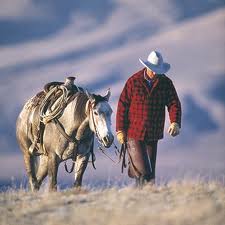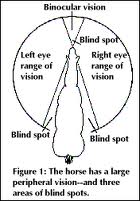|
Fundamental horsemanship requires that you have a good understanding of equine behavior as well as how a horse learns.Fundamental horsemanship
Horses have the capability to learn and remember commands and to respond to those commands. Basically, horses learn through repetition. That is why it is extremely important to be consistent in how you ask the horse to perform certain tasks. To successfully train a horse to perform specific tasks, it is essential that you have a good understanding of behavior as well as how a horse learns or processes information from its environment. Simple tasks like grooming your horse require precaution on the handler's part until the process becomes repetitive and gets ingrained in the horse's mind.

The horse has a relatively small brain in relation to body size. The horse has little if any reasoning power and responds to its environment based on previous experiences and instinct. The design of the horse's brain does not allow for the transfer of information from one hemisphere of the brain to the other. Therefore, when training a horse, you have to teach the proper response from both the left and right. For example, as a young horse becomes proficient at leading from the left side, you will find that the horse will not lead as well when you switch to the right side. Horses are creatures of habit and produce a response due to a conditional request. These requests and responses, good or bad are stored in the horse's memory for future use.
Basic Horse Behavior
The key to fundamental horsemanship is respect, the horse must be taught to respect its handler. In order to develop this trait and to maintain your safety, you must understand the horse's behavior. Horses survive in the wild because of their instinct to flee from danger. This is called the "flight instinct." Therefore, horses may react to unfamiliar objects and circumstances by spooking, or fleeing, from the object of fear.
Your horse's ears will give you clues, too -- they will point in the direction in which its attention is focused. Ears that are "laid back," or flattened backward, warn you that the horse is getting ready to kick or bite. Know the difference between ears that are laid back and ears that simply indicate a resting or listening horse. Horses have powerful hind legs to defend themselves, so it is only normal for them to kick when surprised. Spoiled horses that kick or strike out of habit, however, should be left for professional horse trainers to handle.
Always work with calm but deliberate movements around horses. Nervous handlers can make horses nervous, creating unsafe situations. Never, ever lose your temper or blame your horse for your mistakes. It is best to quit for the day rather than take out your frustrations on the animal.
Approaching the Horse Be careful when approaching a horse that is preoccupied. When approaching a horse in a stall, speak to the horse to get its attention. It is harder to escape a dangerous situation within the confines of a stall, so always make sure you have an out. Even if a horse is aware of your presence, it can be startled by quick movements. When approaching from the rear, advance at an angle.
Always approach the horse in a slow, confident manner. Move slowly but confidently, speaking to the horse as you approach. Read the horse's intention by watching its body language. If it shows signs of moving away, move more slowly, or move away and head it off before it goes too far in another direction. Be careful not to get into a situation where you could get kicked, which can happen if your horse feels cornered or threatened.
Some people use feed to catch their horses, a fundamental horsemanship skill is to teach your horse to be caught without feed, particularly when it is turned out with other horses. Once you are able to touch your horse, rub it on the neck and slowly place the lead rope over the neck. Moving your arms too quickly could encourage it to run from you. Standing alongside the horse's neck, slide the halter on the horse by bringing it upwards on the muzzle and over the head, being careful not to drag it over the nose, eyes or ears. Rough handling can cause horses to become head-shy, making haltering and bridling more difficult.
Tie A Horse Safely
Another basic horsemanship skill is to be able to tie a horse safely, meaning to tie it so that it is unlikely to hurt itself, or anyone or anything nearby. Only tie your horse to objects that it cannot move or pull over. Do not tie a horse to anything that a determined or spooked horse can move. For example, if tying a horse to a fence never tie it to the fence rail, always tie it to the fence post. Fence rails are broken far more easily than fence posts. Never tie your horse to a post or anything else that isn't able to withstand several strong pulls from a frightened horse.
Always tie your horse with a quick release knot and tie your horse at a safe height. A good rule of thumb is to tie a horse so that the rope is tied at about the same height as the horse's back. You can safely tie a horse higher than this, just be sure to allow the horse enough slack that it can hang its head at a natural level. Tying a horse too low will allow a horse to get a leg over the rope, or its head stuck underneath the rope. Tie a horse long enough that it can be comfortable, but not so long that the rope droops down and the horse can step over it. Do not tie with the bridle or the bridle reins. Instead, use a good quality, properly fitting halter and a lead rope. Horses that don't know each other should always be tied with enough distance between each other that they cannot bite or kick one another. Always keep a knife or other suitable tool handy to cut a lead rope if necessary.
Trust
Trust is essential when working with and around horses. Establish a relaxed and confident relationship with the horse. A horse should willingly accept a person’s presence. It is important to have confidence in the horse’s manners and behavior. However, never take an animal for granted and always be alert when working with any horse.
|
 Horses also see differently than humans do, and they can be easily spooked if surprised. They have wide-angle vision, but they also have blind spots directly behind and in front of their bodies. The horse has to position its head to focus its vision, and when it focuses on one area, it cannot see the other areas clearly. For example, when it lifts its head and pricks its ears, it is focusing on something far away.
Horses also see differently than humans do, and they can be easily spooked if surprised. They have wide-angle vision, but they also have blind spots directly behind and in front of their bodies. The horse has to position its head to focus its vision, and when it focuses on one area, it cannot see the other areas clearly. For example, when it lifts its head and pricks its ears, it is focusing on something far away. 
